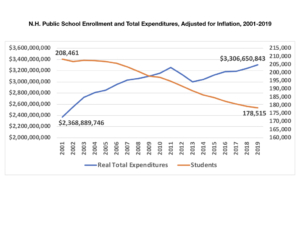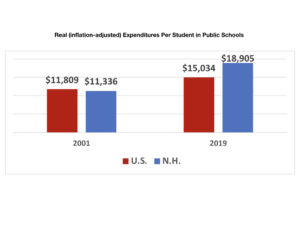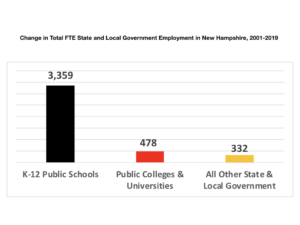Editor’s note: Since the COVID-19 pandemic, educational entrepreneurship has boomed nationwide. New Hampshire has experienced significant growth in the number of entrepreneurs and innovators willing to take on the daunting challenge of building a new educational ecosystem. This year, we’ll be highlighting some of the people and organizations that have begun expanding the education marketplace in the Granite State, as well as the obstacles they face in creating nontraditional learning environments.
Our first installment highlights The Harkness House, a middle school in Nashua for families seeking a nontraditional experience that offers small classrooms and student autonomy.
With an emphasis on smaller class sizes and putting students in charge of their own learning, The Harkness House in Nashua focuses on providing a top-flight education to middle schoolers. Nathan (Nate) Fellman and his founding educators, Stacey Baker and Jean Demers, built it all themselves.
A former eighth-grade language arts teacher and middle-school assistant principal in the Bedford School District, Fellman’s story as an education entrepreneur began with one main catalyst: COVID-19.
Amid all the negative educational consequences brought by the pandemic, Fellman found one silver lining. “We did see during the pandemic one positive thing, and that was…smaller class sizes,” he said.
In August 2021, Bedford started split sessions at the middle school, dropping class sizes in half to around 13 students each in response to the pandemic. The results were eye-opening for Fellman.
“When we had those small classes and everything was turned on its head and you really got to know kids…and you really got to understand what they were interested in, you saw kids come alive who would’ve flown under the radar, and really participate.”
Fellman knew he couldn’t go back to teaching “the same old way.” So he left public education, determined to create an alternative learning environment for families seeking something different.
Brainstorming what would eventually become The Harkness House, Fellman knew one thing for certain: “The biggest thing for me was a commitment to small class sizes.”
This commitment to small classes drew homeschool parents like Carrie Hyde to The Harkness House.
“For our three children, I think they really want to connect with other students their age, and that’s our biggest draw towards [The Harkness House], too, is that they’re only sixth through ninth grade,” Hyde said. “It gives our kids an opportunity to make connections with other students their age.”
Fellman also had a model in mind. The name “Harkness” comes from Philip Exeter Academy’s Harkness model: “Twelve students and one teacher sit around an oval table and discuss the subject at hand.”
This model of instruction—kids engaging in dialogue with each other and the teacher, rather than being lectured—was key to Fellman’s idea.
“This is how adults solve problems,” Fellman said. “They come to a room, they sit around a table, they look each other in the eyes, and they collaborate in this way.”
To make this idea a reality, Fellman had to jump through the necessary regulatory hoops. Although he personally found that the state approval process was not particularly daunting, he gathered that he was the exception.
“We hosted an educational entrepreneurs meeting here with a lot of people trying to start things up, and they were just overwhelmed and daunted because it’s a big application. There are a lot of laws,” he said. “And that I could see being very daunting.”
The minimum requirements for the approval of nonpublic schools are set by statute in the N.H. Code of Administrative Rules. The state Education Department offers guidance and application forms online.
The most significant cost for Fellman was securing a space, renovating it, and getting it up to code. But because his 8,000-square-foot space had previously housed a school, he didn’t run into the usual zoning nightmare that many aspiring entrepreneurs face. Obtaining approval to operate a school where none existed before can be a serious obstacle.
“In talking to people in the field and doing what we’re trying to do, there are a lot of zoning issues,” he observed.
From local ordinances that prohibit people from offering educational services on their property to regulations that were written before the advent of alternative educational methods, a web of rules complicates the task of education innovation.
After securing final approval in August 2022, The Harkness House found its target audience. An education provider focused on making middle-school-aged kids engaged, autonomous, and owners of their learning resonated with one group in particular: the home-education community.
“We went in there and they were engaged with Nate, the kids each had questions, and the way that he doesn’t talk down to them, he talks directly with them, he wants their input, and that they genuinely want to know what they want to learn,” Hyde observed.
In October 2022, The Harkness House launched by developing courses for home-education families. The school offers a la carte classes, as well as two-day and four-day programs for homeschool students.
Starting with just one student, the school grew to 16 by the end of the academic year.
“Every single one of our kids that started with us increased their participation with us,” Fellman said. In fact, eight kids who began as homeschool students are returning to The Harkness House in the upcoming school year on a full-time basis. This will be the school’s first full-time cohort.
Among them will be Stella Kritikou’s three daughters. Enrolled in public schools prior to the pandemic, Kritikou knows she’s found the best fit for her kids. “Now that they’ve been there for almost a year, it’s actually great for them because having that small class has helped them be able to work with other peers in small settings,” she said.
Fellman’s goal for this fall is to enroll 16 full-time kids and 24 home-education students.
Full-time tuition is $14,900, while two-day and four-day programs are $3,100 and just over $5,000, respectively. “Around 50% of our kids are accessing EFA [Education Freedom Account] or ETC [Education Tax Credit] programs through the Children’s Scholarship Fund, which are so helpful for those families,” Fellman noted.
Fellman hopes to further reduce his cost of tuition and make The Harkness House self-sustaining “by, in some fashion, using the service of education…to develop a product that then can be sold to a broader market.” His goal is to eventually film some of his classes and sell the tapes to home-education families (with consent, of course).
Long-term, Fellman’s goal is to fill his space with the 100 students it can hold. Class sizes would be capped at 12 kids each, and they would continue developing the curriculum in partnership with parents and students like they’ve always done.
“We’ll be involved a lot. We’ll be asking questions. We want to know what they’re learning,” Hyde said. “And they’re really good because before they go ahead and watch a movie or before they teach them something, they let us know what they’re doing, so they keep us on the same page. We’re not falling between the cracks.”
Keeping kids from falling through the cracks is a primary goal for Fellman. And that involves engaging students directly in their learning.
“Instead of that 100% top-down, [we’re] really saying, ‘What’s the 20% that every kid needs to know, be able to do?’ and giving the kids a voice at the table for that 80% on how we’re going to get there and what they want to engage in beyond that,” Fellman said.
With that in mind, The Harkness House focuses on language arts, math, social studies, and science, while accepting maximum input from the students to develop their electives.
“Nate’s very open, like as soon as he sits with the kids he asks them, ‘What do you guys want to do? Is this something you’re interested in?’” Kritikou noted. “He leaves it to them, and that’s great because usually these kids don’t get that kind of opportunity in public school.”
From courses like mythology and exploring media bias to the logic of coding, electives are based on student interest. “It allows us to be much more streamlined and do some things, and the core things, really, really well,” Fellman observed.
In this way, the school puts students in charge of their learning. Whether it’s allowing the students the freedom to choose which texts they read for language arts, taking a “virtual road trip” to learn about miles per gallon, gas prices, and budgeting, or turning one of the classrooms into a greenhouse to teach gardening, The Harkness House tackles the core subjects through this hands-on approach, bringing out the best in their students.
“I think what [Fellman] does is he sees what the kids like, he knows what they have to learn, and he incorporates that into what it is they like, so they learn without realizing they’re actually learning,” Kritikou’s mother, Sofia Kretikos, added.
Student autonomy like this is made possible because of the small, individualized classes that define a school like The Harkness House, making it easier for educators to meet the different educational needs of each child.
“Why I recommend the school to everyone is they really give the opportunity for the children to learn in their own way,” Kritikou said. “It’s not something that’s forced on them; they get to choose,” adding that “some kids don’t learn with just reading a book.”
Through innovation and ingenuity, Nate Fellman and The Harkness House aim to make education more responsive to families and students by offering a nontraditional, highly adaptable, and individualized option. Harkness parents say it’s working.
“Watching my 10-year-old granddaughter say, ‘I love to go to school’—she doesn’t want to miss a day—that to me was exciting because I’ve never seen a child that excited to get to school,” Kretikos observed, “and it’s all the way that he’s teaching.”
For evidence of customer satisfaction, Fellman offered an assessment from one of his students: “I feel like I’m learning, but I don’t feel like it’s school.”
The Harkness House, located in Nashua, can be found online at https://www.theharknesshouse.org/.














